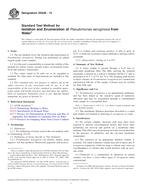Potrebujeme váš súhlas na využitie jednotlivých dát, aby sa vám okrem iného mohli ukazovať informácie týkajúce sa vašich záujmov. Súhlas udelíte kliknutím na tlačidlo „OK“.
ASTM E1563-98(2012)
Standard Guide for Conducting Static Acute Toxicity Tests with Echinoid Embryos
Automaticky preložený názov:
Štandardné príručka pre dirigovanie statické Akútne skúšky toxicity s echinoid zárodkov
NORMA vydaná dňa 1.12.2012
Informácie o norme:
Označenie normy: ASTM E1563-98(2012)
Poznámka: NEPLATNÁ
Dátum vydania normy: 1.12.2012
Kód tovaru: NS-42203
Počet strán: 22
Približná hmotnosť: 66 g (0.15 libier)
Krajina: Americká technická norma
Kategória: Technické normy ASTM
Kategórie - podobné normy:
Mikrobiologie vody
Znečišťování, kontrola znečišťování a konzervace
Biologie. Botanika. Zoologie
Anotácia textu normy ASTM E1563-98(2012) :
Keywords:
acute toxicity test, Arbacia punctulata, Dendraster excentricus, echinoid, EC50 test, embryo development, marine water quality, pluteus larva, sand dollar, sea urchin, sediment test, static toxicity test, Strongylocentrotus droebachiensis, Strongylocentrotus purpuratus, toxicity, toxicology, ICS Number Code 07.080 (Biology. Botany. Zoology),07.100.20 (Microbiology of water),13.020.40 (Pollution, pollution control and conservation)
Doplňujúce informácie
| Significance and Use | |||||||||||||||||||||||||||||||||||||||||||||||||||||||||||||||||||||||||||||||||||||||||||||||||||||||||||||||||||||
|
5.1 An acute toxicity test is conducted to obtain information concerning the acute effects of a short-term exposure of organisms to a test material under specific experimental conditions. An acute toxicity test does not provide information concerning whether delayed effects will occur. 5.2 Because embryos and larvae are usually assumed to be the most sensitive life stages of these echinoid species, and because some of these species are commercially and recreationally important, the results of these acute tests are often considered to be a good indication of the acceptability of pollutant concentrations to saltwater species in general. The results of these acute toxicity tests are often assumed to be an important consideration when assessing the hazard of materials to other saltwater organisms (see Guides E724 and E1023) or when deriving water quality criteria for saltwater organisms 5.3 The results of acute toxicity tests might be used to predict acute effects likely to occur to aquatic organisms in field situations as a result of exposure under comparable conditions, except that toxicity to benthic species might depend on sorption or settling of the test material onto the substrate. 5.4 The results of acute tests might be used to compare the acute sensitivities of different species and the acute toxicities of different test materials, and to determine the effects of various environmental factors on the results of such tests. 5.5 The results of acute toxicity tests might be useful for studying the biological availability of, and structure-activity relationships between, test materials. 5.6 The results of acute toxicity tests will depend on temperature, composition of the dilution water, condition of the test organisms, and other factors. |
|||||||||||||||||||||||||||||||||||||||||||||||||||||||||||||||||||||||||||||||||||||||||||||||||||||||||||||||||||||
| 1. Scope | |||||||||||||||||||||||||||||||||||||||||||||||||||||||||||||||||||||||||||||||||||||||||||||||||||||||||||||||||||||
|
1.1 This guide covers procedures for obtaining laboratory data concerning the acute effects of a test material on embryos and the resulting larvae of echinoid embryos (sea urchins and sand dollars) during static 48- to 96-h exposures. These procedures have generally been used with U.S. East Coast (1.2 Other modifications of these procedures might be justified by special needs or circumstances. Although using procedures appropriate to a particular species or special needs and circumstances is more important than following prescribed procedures, the results of tests conducted by using unusual procedures are not likely to be comparable with those of many other tests. The comparison of results obtained by using modified and unmodified versions of these procedures might provide useful information concerning new concepts and procedures for conducting acute tests starting with embryos of echinoids. 1.3 These procedures are applicable to most chemicals, either individually or in formulations, commercial products, or known mixtures. With appropriate modifications, these procedures can be used to conduct acute tests on temperature, dissolved oxygen, and pH and on such materials as aqueous effluents (see also Guide E1192), leachates, oils, particulate matter, surface waters and sediments (Annex A1). Renewal tests might be preferable to static tests for materials that have a high oxygen demand, are highly volatile, are rapidly transformed biologically or chemically in aqueous solution, or are removed from test solutions in substantial quantities by the test chambers or organisms during the test. 1.4 Results of acute toxicity tests with echinoid embryos should usually be reported as the 50 % effect concentration (EC50) based on the total abnormally developed embryos and larvae. In some situations, it might only be necessary to determine whether a specific concentration is acutely toxic to embryos or whether the EC50 is above or below a specific concentration. 1.5 This guide is arranged as
follows:
Podobné normy: Historická Historická Historická Historická Historická Historická Odporúčame:Aktualizácia technických noriem
Chcete mať istotu, že používate len platné technické normy? Posledná aktualizácia: 2025-12-16 (Počet položiek: 2 252 193) |



 ASTM D4454-85(2009)..
ASTM D4454-85(2009).. ASTM D4455-85(2014)..
ASTM D4455-85(2014).. ASTM D5246-13
ASTM D5246-13 ASTM D5392-14
ASTM D5392-14 ASTM D5465-93(2012)..
ASTM D5465-93(2012).. ASTM D6734-01(2009)..
ASTM D6734-01(2009)..
 Cookies
Cookies
